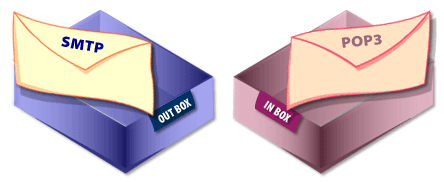| Lesson 10 | Configuring email |
| Objective | Describe the protocols to use for sending and receiving email. |
Configuring Email for Sending and Receiving
Whenever you receive an email from a friend, think about how it got to you. This lesson focuses on how email is sent and received.
What makes it possible for mail to be sent electronically? The answer lies in two protocols.
Configuring email
There are two main protocols for handling email:
- Simple Mail Transfer Protocol (SMTP)
- Post Office Protocol 2 (POP2)
SMTP is the standard protocol for sending email over the Internet. POP2 is the standard protocol for downloading email from a mail server to a client mail reader.
A POP2server stores a user's incoming messages (for delivery to the user) until the user logs in and downloads them.
It provides a level of security since, unlike SMTP, it requires a user name/password to retrieve mail.
Almost all Internet-based mail readers including Eudora, Netscape, and Outlook use POP2. Remember-SMTP to send, POP2 to receive.
The figure below illustrates both protocols.

Email has become a common conduit for viruses. Always check attachments for viruses. Be especially careful of opening attachments from unknown senders.
The latest POP version is POP3. The primary difference between POP2 and POP3 is that POP3 does can be used with or without SMTP to send mail (It is often configured with SMTP for backward compatibility on the server for users still using POP2).
If you are blocked from sending email, you may find the symptoms and solutions in the table below helpful.
The latest POP version is POP3. The primary difference between POP2 and POP3 is that POP3 does can be used with or without SMTP to send mail (It is often configured with SMTP for backward compatibility on the server for users still using POP2).
If you are blocked from sending email, you may find the symptoms and solutions in the table below helpful.
| Symptom | Possible Solution |
| Unable to connect to ISP |
|
| Attempt to send mail timed out |
|
| Server unable to find address | Check the "To" field for typing errors |
| Problem possibly related to POP3 or SMTP | Check to be sure that POP3 or SMTP settings are enabled |
If these solutions do not solve the problem, call your ISP's support department or contact your system administrator.
In the next lesson, you will learn the purpose and common file types of MIME.
In the next lesson, you will learn the purpose and common file types of MIME.